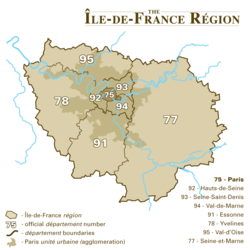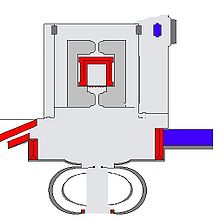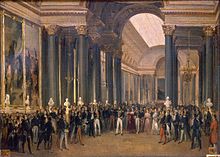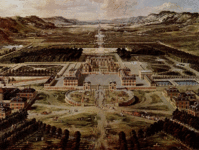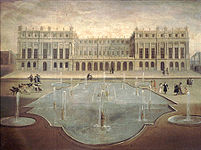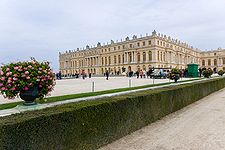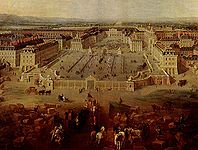- Palace of Versailles
-
"Versailles" redirects here. For the city, see Versailles (commune). For other uses, see Versailles (disambiguation).
Palace of Versailles Château de Versailles 
The interior court of the Palace of VersaillesGeneral information Location Versailles, France Coordinates 48°48′16″N 2°07′23″E / 48.804404°N 2.123162°ECoordinates: 48°48′16″N 2°07′23″E / 48.804404°N 2.123162°E Technical details Floor area 67,000 m2
Number of windows 2,153 Number of rooms 2,300 [1] Staircases 67 Paintings in the museum’s collection 6,123 Drawings in museum’s collection 1,500 Engravings in museum’s collection 15,034 Sculptures in museum’s collection 2,102 Pieces of furniture and objets d’art 5,210 Website Official site of the Chateau de Versailles Official name: Palace and Park of Versailles Type: Cultural Criteria: i, ii, vi Designated: 1979 (3rd session) Reference #: 83 State Party: France Region: Europe The Palace of Versailles (
 /vɛərˈsaɪ/ vair-sy or /vərˈsaɪ/; French: [vɛʁˈsaj]), or simply Versailles, is a royal château in Versailles in the Île-de-France region of France. In French it is the Château de Versailles.
/vɛərˈsaɪ/ vair-sy or /vərˈsaɪ/; French: [vɛʁˈsaj]), or simply Versailles, is a royal château in Versailles in the Île-de-France region of France. In French it is the Château de Versailles.When the château was built, Versailles was a country village; today, however, it is a suburb of Paris, some 20 kilometres southwest of the French capital. The court of Versailles was the centre of political power in France from 1682, when Louis XIV moved from Paris, until the royal family was forced to return to the capital in October 1789 after the beginning of the French Revolution. Versailles is therefore famous not only as a building, but as a symbol of the system of absolute monarchy of the Ancien Régime.
History
Origins
The earliest mention of the name of Versailles is found in a document dated 1038, the Charte de l'abbaye Saint-Père de Chartres (Charter of the Saint-Père de Chartres Abbey) (Guérard, 1840), in which one of the signatories was a certain Hugo de Versailliis (Hugues de Versailles), who was seigneur of Versailles. During this period, the village of Versailles centred on a small castle and church and the area was governed by a local lord. Its location on the road from Paris to Dreux and Normandy brought some prosperity to the village but, following an outbreak of the Plague and the Hundred Years' War, the village was largely destroyed and its population sharply declined (Bluche, 1991; Thompson, 2006; Verlet, 1985)
In 1575, Albert de Gondi, a naturalized Florentine who gained prominence at the court of Henry II, purchased the seigneury of Versailles. In the early seventeenth century, Gondi invited Louis XIII on several hunting trips in the forests surrounding Versailles. Pleased with the location, Louis ordered the construction of a hunting lodge in 1624. Designed by Philibert Le Roy, the structure, a small château, was constructed of stone and red brick with a based roof. Eight years later, Louis obtained the seigneury of Versailles from the Gondi family and began to make enlargements to the château (Batiffol, 1913; Bluche, 1991; Marie, 1968; Nolhac, 1901; Verlet, 1985).
Louis XIV had played and hunted at the site as a boy.[2] This structure would become the core of the new palace.[citation needed]
Ancien Régime
Louis XIV
Louis XIII's successor, Louis XIV, had a great interest in Versailles. He settled on the royal hunting lodge at Versailles and over the following decades had it expanded into one of the largest palaces in the world (Félibien, 1703; Marie, 1972; Verlet, 1985). Beginning in 1661, the architect Louis Le Vau, landscape architect André Le Nôtre, and painter-decorator Charles Le Brun began a detailed renovation and expansion of the château. This was done to fulfill Louis XIV's desire to establish a new centre for the royal court. Following the Treaties of Nijmegen in 1678, he began to gradually move the court to Versailles. The court was officially established there on 6 May 1682.
By moving his court and government to Versailles, Louis XIV hoped to extract more control of the government from the nobility, and to distance himself from the population of Paris. All the power of France emanated from this centre: there were government offices here, as well as the homes of thousands of courtiers, their retinues, and all the attendant functionaries of court (Solnon, 1987). By requiring that nobles of a certain rank and position spend time each year at Versailles, Louis prevented them from developing their own regional power at the expense of his own and kept them from countering his efforts to centralise the French government in an absolute monarchy (Bluche, 1986, 1991; Bendix, 1978; Solnon, 1987). The meticulous and strict court etiquette that Louis established, which overwhelmed his heirs with its petty boredom, was epitomised in the elaborate ceremonies and exacting procedures that accompanied his rising in the morning, known as the Lever, divided into a petit lever for the most important and a grand lever for the whole court. Like other French court manners, étiquette was quickly imitated in other European courts (Benichou, 1948; Bluche, 1991; Solnon 1987).
The expansion of the château became synonymous with the absolutism of Louis XIV (Bluche, 1986, 1991). In 1661, following the death of Cardinal Mazarin, chief minister of the government, Louis had declared that he would be his own chief minister. The idea of establishing the court at Versailles was conceived to ensure that all of his advisors and provincial rulers would be kept close to him. He feared that they would rise up against him and start a revolt. He thought that if he kept all of his potential threats near him, they would be powerless. After the disgrace of Nicolas Fouquet in 1661 – Louis claimed the finance minister would not have been able to build his grand château at Vaux-le-Vicomte without having embezzled from the crown – Louis, after the confiscation of Fouquet’s state, employed the talents of Le Vau, Le Nôtre, and Le Brun, who all had worked on Vaux-le-Vicomte, for his building campaigns at Versailles and elsewhere. For Versailles, there were four distinct building campaigns (after minor alterations and enlargements had been executed on the château and the gardens in 1662–1663), all of which corresponded to Louis XIV’s wars (Bluche, 1986, 1991; Verlet, 1985).
First building campaign
The first building campaign (1664–1668) commenced with the Plaisirs de l’Île enchantée of 1664, a fête that was held between 7 and 13 May 1664. The fête was ostensibly given to celebrate the two queens of France – Anne of Austria, the Queen Mother, and Marie-Thérèse, Louis XIV’s wife, but in reality honored the king’s mistress, Louise de La Vallière. The celebration of the Plaisirs de l’Île enchantée is often regarded as a prelude to the War of Devolution, which Louis waged against Spain. The first building campaign (1664–1668) involved alterations in the château and gardens to accommodate the 600 guests invited to the party (Nolhac, 1899, 1901; Marie, 1968; Verlet, 1985).
Second building campaign
The second building campaign (1669–1672) was inaugurated with the signing of the Treaty of Aix-la-Chapelle, which ended the War of Devolution. During this campaign, the château began to assume some of the appearance that it has today. The most important modification of the château was Le Vau’s envelope of Louis XIII’s hunting lodge. The enveloppe – often referred to as the château neuf to distinguish it from the older structure of Louis XIII – enclosed the hunting lodge on the north, west, and south. The new structure provided new lodgings for the king and members of his family. The main floor – the piano nobile – of the château neuf was given over entirely to two apartments: one for the king, and one for the queen. The Grand appartement du roi occupied the northern part of the château neuf and Grand appartement de la reine occupied the southern part. The western part of the enveloppe was given over almost entirely to a terrace, which was later enclosed with the construction of the Hall of Mirrors (Galerie des Glaces). The ground floor of the northern part of the château neuf was occupied by the appartement des bains, which included a sunken octagonal tub with hot and cold running water. The king’s brother and sister-in-law, the duke and duchesse d’Orléans occupied apartments on the ground floor of the southern part of the château neuf. The upper story of the château neuf was reserved for private rooms for the king to the north and rooms for the king’s children above the queen’s apartment to the south (Nolhac, 1901; Marie, 1972; Verlet, 1985).
Significant to the design and construction of the grands appartements is that the rooms of both apartments are of the same configuration and dimensions – a hitherto unprecedented feature in French palace design. It has been suggested that this parallel configuration was intentional as Louis XIV had intended to establish Marie-Thérèse d’Autriche as queen of Spain, and thus thereby establish a dual monarchy (Johnson, 1981). Louis XIV’s rationale for the joining of the two kingdoms was seen largely as recompense for Philip IV's failure to pay his daughter Marie-Thérèse’s dowry, which was among the terms of capitulation to which Spain agreed with the promulgation of the Treaty of the Pyrenees, which ended the war between France and Spain that began in 1635 during the Thirty Years’ War. Louis XIV regarded his father-in-law’s act as a breach of the treaty and consequently engaged in the War of Devolution.
Both the grand appartement du roi and the grand appartement de la reine formed a suite of seven enfilade rooms. Each room is dedicated to one of the then known celestial bodies and is personified by the appropriate Greco-Roman deity. The decoration of the rooms, which was conducted under Le Brun's direction depicted the “heroic actions of the king” and were represented in allegorical form by the actions of historical figures from the antique past (Alexander the Great, Augustus, Cyrus, etc.) (Berger, 1986; Félibien, 1674; Verlet, 1985).
Third building campaign
With the signing of the Treaty of Nijmegen in 1678, which ended the Dutch War, the third building campaign at Versailles began (1678–1684). Under the direction of the architect, Jules Hardouin-Mansart, the Palace of Versailles acquired much of the look that it has today. In addition to the Hall of Mirrors, Hardouin-Mansart designed the north and south wings, which were used, respectively, by the nobility and Princes of the Blood, and the Orangerie. Le Brun was occupied not only with the interior decoration of the new additions of the palace, but also collaborated with Le Nôtre's in landscaping the palace gardens (Berger, 1985; Thompson, 2006; Verlet, 1985). As symbol of France’s new prominence as a European super-power, Louis XIV officially installed his court at Versailles in May of 1682 (Bluche, 1986, 1991).
Fourth building campaign
Soon after the crushing defeat of the War of the League of Augsburg (1688–1697) and owing possibly to the pious influence of Madame de Maintenon, Louis XIV undertook his last building campaign at Versailles. The fourth building campaign (1699–1710) concentrated almost exclusively on construction of the royal chapel designed by Hardouin-Mansart and finished by Robert de Cotte and his team of decorative designers. There were also some modifications in the appartement du roi, namely the construction of the Salon de l’Œil de Bœuf and the King’s Bedchamber. With the completion of the chapel in 1710, virtually all construction at Versailles ceased; building would not be resumed at Versailles until some twenty years later during the reign of Louis XV (Nolhac, 1911; Marie, 1976, 1984; Verlet, 1985).
Plans of the evolution of Versailles 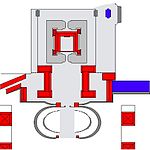
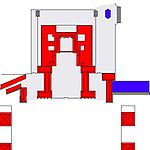
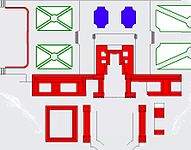
The palace in 1668 The palace in 1674 The palace in 1680 Louis XV
After the death of the Louis XIV in 1715, the five-year old king Louis XV, the court, and the Régence government of Philippe d’Orléans returned to Paris. In May 1717, during his visit to France, the Russian czar Peter the Great stayed at the Grand Trianon. His time at Versailles was used to observe and study the palace and gardens, which he later used as a source of inspiration when he built Peterhof on the Bay of Finland west of Saint Petersburg (Verlet, 1985).
During the reign of Louis XV, Versailles underwent transformation, but not on the scale that had been seen during the reign of Louis XIV. When the king and the court returned to Versailles in 1722, the first project was the completion of the Salon d'Hercule, which had been begun during the last years of Louis XIV's reign but was never finished due to the king’s death.
Significant among Louis XV’s contributions to Versailles were the petit appartement du roi; the appartements de Mesdames, the appartement du dauphin, and the appartement de la dauphine on the ground floor; and the two private apartments of Louis XV – petit appartement du roi au deuxième étage (later transformed into the appartement de Madame du Barry) and the petit appartement du roi au troisième étage – on the second and third floors of the palace. The crowning achievements of Louis XV’s reign were the construction of the Opéra and the Petit Trianon (Verlet, 1985).
Equally significant was the destruction of the Escalier des Ambassadeurs (Ambassadors' Stair), the only fitting approach to the State Apartments, which Louis XV undertook to make way for apartments for his daughters.
The gardens remained largely unchanged from the time of Louis XIV; only the completion of the Bassin de Neptune between 1738 and 1741 was the most important legacy Louis XV made to the gardens (Marie 1984; Thompson, 2006; Verlet 1985). Towards the end of his reign, Louis XV, under the advice of Ange-Jacques Gabriel, began to remodel the courtyard façades of the palace. With the objective revetting the entrance of the palace with classical façades, Louis XV began a project that was continued during the reign of Louis XVI, but which did not see completion until the 20th century (Verlet, 1985).
Louis XVI
Much of Louis XVI’s contributions to Versailles were largely dictated by the unfinished projects left to him by his grandfather. Shortly after his ascension, Louis XVI ordered a complete replanting of the gardens with the intention of transforming the jardins français to an English-style garden, which had become popular during the late 18th century (Verlet, 1985). In the palace, the library and the salon des jeux in the petit appartement du roi and the decoration of the petit appartement de la reine for Marie-Antoinette are among the finest examples of the style Louis XVI (Verlet, 1945; 1985)
French Revolution
On 6 October 1789, the royal family had to leave Versailles and to move to the Tuileries Palace in Paris, as a result of the Women's March on Versailles.[3] During the early years of the French Revolution, preservation of the palace was largely in the hands of the citizens of Versailles. In October 1790, Louis XVI ordered the palace to be emptied of its furniture, requesting that most be sent to the Tuileries Palace. In response to the order, the mayor of Versailles and the municipal council met to draft a letter to Louis XVI in which they stated that if the furniture was removed, it would certainly precipitate economic ruin on the city (Gatin, 1908).[4] A deputation from Versailles met with the king on 12 October after which Louis XVI, touched by the sentiments of the residents of Versailles, rescinded the order. However, eight months later, the fate of Versailles was sealed.
On 21 June 1791, Louis XVI was arrested at Varennes after which the Assemblée nationale constituante accordingly declared that all possessions of the royal family had been abandoned. To safeguard the palace, the Assemblée nationale constituante ordered the palace of Versailles to be sealed. On 20 October 1792 a letter was read before the National Convention in which Jean-Marie Roland de la Platière, interior minister, proposed that the furnishings of the palace and those of the residences in Versailles that had been abandoned be sold and that the palace be either sold or rented. The sale of furniture transpired at auctions held between 23 August 1793 and 30 nivôse an III (19 January 1795). Only items of particular artistic or intellectual merit were exempt from the sale. These items were consigned to be part of the collection of a museum, which had been planned at the time of the sale of the palace furnishings.
In 1793, Charles-François Delacroix deputy to the Convention and father of the painter Eugène Delacroix proposed that the metal statuary in the gardens of Versailles be confiscated and sent to the foundry to be made into cannon (Gatin, 1908). The proposal was debated but eventually it was tabled. On 28 floréal an II (5 May 1794) the Convention decreed that the château and gardens of Versailles, as well as other former royal residences in the environs, would not be sold but placed under the care of the Republic for the public good (Fromegot, 1903). Following this decree, the château became a repository for art work seized from churches and princely homes. As a result of Versailles serving as a repository for confiscated art works, collections were amassed that eventually became part of the proposed museum (Fromegot, 1903).
Among the items found at Versailles at this time a collection of natural curiosities that has been assembled by the sieur Fayolle during his voyages in America. The collection was sold to the comte d’Artois and was later confiscated by the state. Fayolle, who had been nominated to the Commission des arts, became guardian of the collection and was later, in June 1794, nominated by the Convention to be the first directeur du Conservatoire du Muséum national de Versailles (Fromageot, 1903). The next year, André Dumont the people's representative, became administrator for the department of the Seine-et-Oise. Upon assuming his administrative duties, Dumont was struck with the deplorable state into which the palace and gardens had sunk. He quickly assumed administrative duties of the château and assembled a team of conservators to oversee the various collections of the museum (Fromageot, 1903).
One of Dumont’s first appointments was that of Huges Lagarde (10 messidor an III (28 June 1795), a wealthy soap merchant from Marseille with strong political connections, as bibliographer of the museum. With the abandonment of the palace, there remained no less than 104 libraries which contained in excess of 200,000 printed volumes and manuscripts. Lagarde, with his political connections and his association with Dumont, became the driving force behind Versailles as a museum at this time. Lagarde was able to assemble a team of curators including sieur Fayolle for natural history and, Louis Jean-Jacques Durameau, the painter responsible for the ceiling painting in the Opéra, was appointed as curator for painting (Fromageot, 1903).
Owing largely to political vicissitudes that occurred in France during the 1790s, Versailles succumbed to further degradations. Mirrors were assigned by the finance ministry for payment of debts of the Republic and draperies, upholstery, and fringes were confiscated and sent to the mint to recoup the gold and silver used in their manufacture. Despite its designation as a museum, Versailles served as an annex to the Hôtel des Invalides pursuant to the decree of 7 frimaire an VIII (28 November 1799), which commandeered part of the palace and which had wounded soldiers being housed in the petit appartement du roi (Gatin, 1908)
In 1797, the Muséum national was reorganised and renamed Musée spécial de l’École française (Dutilleux, 1887). The grands appartements were used as galleries in which the morceaux de réception submitted by artists seeking admission to the Académie royale de peinture et de sculpture during the 17th and 18th centuries, the series The Life of Saint Bruno by Eustache Le Sueur and the Life of Marie de Médicis by Peter Paul Rubens were placed on display. The museum, which included the sculptures in the garden, became the finest museum of classic French art that had existed (Verlet, 1985).
First Empire
With the advent of Napoléon and the First Empire, the status of Versailles changed. Paintings and art work that had previously been assigned to Muséum national and the Musée spécial de l’École française were systematically dispersed to other locations and eventually the museum was closed. In accordance to provisions of the 1804 Constitution, Versailles was designated as an imperial palace for the department of the Seine-et-Oise.[5]
While Napoléon did not reside in the château, apartments were, however, arranged and decorated for the use of the empress Marie-Louise. The emperor chose to reside at the Grand Trianon. The château continued to serve, however, as an annex of the Hôtel des Invalides (Mauguin, 1940–1942; Pradel, 1937; Verlet, 1985). Nevertheless, on 3 January 1805, Pope Pius VII, who came to France to officiate at Napoléon's coronation, visited the palace and blessed the throng of people gathered on the parterre d'eau from the balcony of the Hall of Mirrors (Mauguin, 1940–1942).
Bourbon Restoration
The Bourbon Restoration saw little activity at Versailles. Areas of the gardens were replanted but no significant restoration and modifications of the interiors were undertaken, despite the fact that Louis XVIII would often visit the palace and walk through the vacant rooms (Manse, 2004; Thompson, 2006). Charles X chose the Tuileries Palace over Versailles and rarely visited his former home (Castelot, 2001).
July Monarchy
With the Revolution of 1830 and the establishment of the July Monarchy, the status of Versailles changed. In March 1832, the Loi de la Liste civile was promulgated, which designated Versailles as a crown dependency. Like Napoléon before him, Louis-Philippe chose to live at the Grand Trianon; however, unlike Napoléon, Louis-Philippe did have a grand design for Versailles.
In 1833, Louis-Philippe proposed the establishment of a museum dedicated to “all the glories of France,” which included the Orléans dynasty and the Revolution of 1830 that put Louis-Philippe on the throne of France. For the next decade, under the direction of Eugène-Charles-Frédéric Nepveu and Pierre-François-Léonard Fontaine, the château underwent irreversible alterations (Constans, 1985; 1987; Mauguin, 1937; Verlet, 1985). The museum was officially inaugurated on 10 June 1837 as part of the festivities that surrounded the marriage of the Prince royal, Ferdinand-Philippe d’Orléans with princess Hélène of Mecklenburg-Schwerin and represented one of the most ambitious and costly undertakings of Louis-Philippe’s reign. Over, the emperor at the king’s home – Napoléon at Louis XIV’s; in a word, it is having given to this magnificent book that is called French history this magnificent binding that is called Versailles (Victor Hugo).[6]
Later, Balzac characterised, in less laudatory terms, the effort as the “hospital of the glories of France” (Balzac, 1853).
The aile du Midi, was given over to the galerie des Balles, which necessitated the demolition of most of the apartments of the Princes of the Blood who lived in this part of the palace during the Ancien Régime. The galerie des Batailles was an epigone of the Grande galerie of the Louvre and was intended to glorify French military history from the Battle of Tolbiac (traditionally dated 495) to the Battle of Wagram (5–6 July 1809). While a number of the paintings displayed in the galerie des Batailles were of questionable quality, a few masterpieces, such as the Battle of Taillebourg by Eugène Delacroix, were displayed here. Part of the aile du Nord was converted for the Salle des Croisades, a room dedicated to famous knights of the Crusades and decorated with their names and coats of arms. The apartments of the dauphin and the dauphine as well as those of Louis XV’s daughters on the ground floor of the corps de logis were transformed into portrait galleries. To accommodate the displays, some of the boiseries were removed and either put into storage or sold. During the Prussian occupation of the palace in 1871, the boiseries in storage were burned as firewood (Constans, 1985; 1987; Mauguin, 1937; Verlet,1985).
Second Empire
During the Second Empire, the museum remained essentially intact. The palace did serve as the backdrop for a number of state events including the visit by Queen Victoria.
From the Second Empire to today
Versailles under Pierre de Nolhac
Pierre de Nolhac arrived at the Palace of Versailles in 1887 and was appointed curator of the museum 18 November, 1892.[7] Upon arrival at the Palace, he planned to introduce real historical galleries, organized scientifically, in contrast to the approach of Louis-Philippe, who had created the first galleries in a manner aimed at glorifying the history of France. At the same time, Nolhac began to restore the palace to its appearance before the Revolution. To achieve these two goals, Nolhac removed rooms, took down the artworks and gave the rooms some historical scenery. He explained in his memoirs, for example that "the first room sacrificed was that of the kings of France which had walls lined with effigies, real and imaginary, of our kings since Clovis".[8] The revolution wrought by Nolhac produced a new awareness of the castle. Members of high society and nobility, such as the Duke of Aumale and the Empress Eugenie flocked to see new developments. Nolhac also working to bring in foreign personalities. On 8 October 1896, Tsar Nicolas II and his wife arrived at Versailles. Nolhac also organized events aimed at raising the awareness of potential donors to the Palace. The owner of the New York Herald, Gordon Bennett, gave 25,000 francs for restructuring the eighteenth century rooms. The development of private donations led to the creation of the Friends of Versailles in June 1907.
The van der Kemp period
Under the aegis of Gérald van der Kemp, chief conservator of the museum from 1952 to 1980, the Palace witnessed some of its most ambitious conservation and restoration projects: new roofing for the galerie des glaces; restoration of the chambre de la reine; restoration of the chambre de Louis XIV; restoration of the Opéra (Lemoine, 1976). At this time, the ground floor of the aile du Nord was converted into a gallery of French history from the 17th century to the 19th century. Additionally, at this time, policy was established in which the French government would aggressively seek to acquire as much of original furniture and artwork that had been dispersed at the time of the Revolution of 1789 as possible (Kemp, 1976; Meyer, 1985).
Contemporary Versailles
With the past and ongoing restoration and conservation projects at Versailles, the Fifth Republic has enthusiastically promoted the museum as one of France’s foremost tourist attractions (Opperman, 2004). The palace, however, still serves political functions. Heads of state are regaled in the Hall of Mirrors; the Sénat and the Assemblée nationale meet in congress in Versailles to revise or otherwise amend the French Constitution, a tradition that came into effect with the promulgation of the 1875 Constitution.[9] Public establishment of the museum and Château de Versailles Spectacles recently organised the Jeff Koons Versailles exhibition. Jeff Koons said that "I hope the juxtaposition of today's surfaces, represented by my work, with the architecture and fine arts of Versailles will be an exciting interaction for the viewer.[10]
Elena Geuna and Laurent Le Bon, curators of the exhibition present it as follow: "It is the city aspect that underlies this entire venture. In recent years, many a cultural institution has attempted a confrontation between a heritage setting and contemporary works. The originality of this exhibition seems to us somewhat different, as regards both the chosen venue and the way it has been laid out. Echo, dialectic, opposition, counterpoint... Not for us to judge!"[10]
Images of Versailles
Views of the Palace of Versailles 
Panoramic view from the park 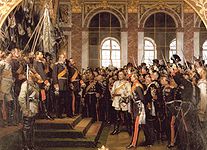
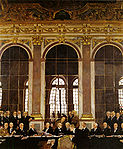
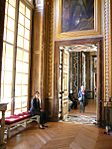
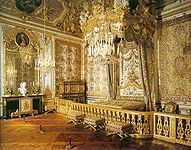
”Proclamation of the German Empire, 18 January 1871”, 1877 by Anton von Werner. “The Signing of Peace in the Hall of Mirrors, Versailles, 28 June 1919” by Sir William Orpen, KBE. Salle du Sacre with a view toward Salle des Gardes de la Reine in the Grand Appartement of the queen. The Queen's bedchamber. There is a barely discernible 'hidden door' in the corner near the jewel cabinet by Schwerdfeger (1787) through which Marie Antoinette escaped the night of 5/6 October 1789 when the Paris mob stormed Versailles. Features of the Palace of Versailles
Grands appartements
As a result of Le Vau’s enveloppe of Louis XIII’s château, the king and the queen had new apartments in the new addition, known at the time as the château neuf. The grands appartements, which are known respectively as the grand appartement du roi and the grand appartement de la reine, occupied the main or principal floor of the château neuf. Le Vau’s design for the state apartments closely followed Italian models of the day, as evidenced by the placement of the apartments on the next floor up from the ground level – the piano nobile – a convention the architect borrowed from 16th and 17th century Italian palace design (Berger, 1986; Verlet, 1985).
Grand appartement du roi
Le Vau’s plan called for an enfilade of seven rooms, each dedicated to one of the then known planets and their associated titular Roman deity. Le Vau’s plan was bold as he designed a heliocentric system that centred on the Salon of Apollo. The salon d’Apollon originally was designed as the king’s bedchamber, but served as a throne room. During the reign of Louis XIV (until 1689), a solid silver throne stood on a Persian carpet covered dais on the south wall of this room (Berger, 1986; Dangeau, 1854–1860; Josephson, 1926; 1930; Verlet, 1985).
The original arrangement of the enfilade of rooms was:
- Salon de Diane (Diana, Roman goddess of the hunt; associated with the Moon)[11]
- Salon de Mars (Mars, Roman god of war; associated with the planet Mars)
- Salon de Mercure (Mercury, Roman god of trade, commerce, and the Liberal Arts; associated with the planet Mercury)
- Salon d’Apollon (Apollo, Roman god of the Fine Arts; associated with the Sun)
- Salon de Jupiter (Jupiter, Roman god of law and order; associated with the planet Jupiter)
- Salon de Saturne (Saturn, Roman god of agriculture and harvest; associated with the planet Saturn)
- Salon de Vénus (Venus, Roman goddess of love and beauty; associated with the planet Venus)
The configuration of the grand appartement du roi conformed to contemporary conventions in palace design (Baillie, 1967). However, owing to Louis XIV’s personal taste and with the apartment’s northern exposure, Louis XIV found the rooms too cold and opted to live in the rooms previously occupied by his father. The grand appartement du roi was reserved for court functions – such as the thrice-weekly appartement evenings given by Louis XIV for members of the court (Berger, 1986; La Varende, 1959; Marie, 1968, 1972; Nolhac, 1911; Verlet, 1985).
The rooms were decorated by Le Brun and demonstrated Italian influences, particularly that of Pietro da Cortona, with whom Le Brun studied while he was in Florence. Le Brun was influenced by the decorative style da Cortona devised for the decoration of the Pitti Palace in Florence, which influenced his style Louis XIV at Versailles. The quadratura style of the ceilings evoke Pietro Cortona’s Sale dei Planeti at the Pitti, but Le Brun’s decorative schema is more complex (Blunt, 1980; Campbell, 1977). In his 1674 publication about the grand appartement du roi, André Félibien described the scenes depicted in the coves of the ceilings of the rooms as allegories depicting the “heroic actions of the king” (Félibien, 1674). Accordingly, one finds scenes of the exploits of Augustus, Alexander the Great, and Cyrus alluding to the deeds of Louis XIV (Lighthart, 1997; Sabatier, 1999). For example, in the salon d’Apollon, the cove painting “Augustus building the port of Misenum”[12] alludes to the construction of the port at La Rochelle; or, depicted in the south cove of the salon de Mercure is “Ptolemy II Philadelphus in his Library”, which alludes to Ptolemy’s construction of the Great Library of Alexandria and which accordingly serves as an allegory to Louis XIV’s expansion of the Bibliothèque du roi.[13] Complementing the rooms’ decors were pieces of massive silver furniture. Regrettably, owing to the War of the League of Augsburg, in 1689 Louis XIV ordered all of this silver furniture to be sent to the mint, to be melted down to help defray the cost of the war (Berger, 1986; Dangeau, 1854–1860; Josephson, 1926; 1930; Marie, 1968, 1972, 1976; Nolhac, 1911; Verlet, 1985).
Le Vau’s original plan for the grand appartement du roi was short-lived. With the inauguration of the third building campaign, which suppressed the terrace linking the apartments of the king and queen, the salon de Jupiter, the salon de Saturne, and the salon de Vénus for the construction of the Hall of Mirrors, the configuration of the grand appartement du roi was altered. The decorative elements of the salon de Jupiter was removed and reused in the decoration of the salle des gardes de la reine; and elements of the decoration of the first salon de Vénus, which opened onto the terrace, were reused in the salon de Vénus that we see today[14] (Marie, 1972, 1976; Nolhac, 1925; Verlet, 1985).
From 1678 to the end of Louis XIV’s reign, the grand appartement du roi served as the venue for the king’s thrice-weekly evening receptions, known as les soirées de l’appartement. For these parties, the rooms assumed specific functions:
- Salon de Vénus: buffet tables were arranged to display food and drink for the king’s guests.
- Salon de Diane: served as a billiard room.
- Salon de Mars: served as a ballroom.
- Salon de Mercure: served as a gaming (cards) room.
- Salon d’Apollon: served as a concert or music room.
In the 18th century during the reign of Louis XV, the grand appartement du roi was expanded to include the salon de l’Abondance (Hall of Plenty) – formerly the entry vestibule of the petit appartement du roi – and the salon d'Hercule – occupying the tribune level of the former chapel of the palace (Verlet, 1985).
Grand appartement de la reine
Forming a parallel enfilade with that of the grand appartement du roi, the grand appartement de la reine served as the residence of three queens of France – Marie-Thérèse d’Autriche, wife of Louis XIV, Marie Leczinska, wife of Louis XV, and Marie-Antoinette, wife of Louis XVI. Additionally, Louis XIV's granddaughter-in-law, Princess Marie-Adélaïde of Savoy, as duchesse de Bourgogne, occupied these rooms from 1697 (the year of her marriage) to her death in 1712.[15]
When Le Vau’s enveloppe of the château vieux was completed, the grand appartement de la reine came to include a suite of seven enfilade rooms with an arrangement that mirrored almost exactly the grand appartement du roi. The configuration was:
- Chapel – which was pendant with the salon de Diane in the grand appartement du roi[16]
- Salle de gardes – which was pendant with the salon de Mars in the grand appartement du roi
- Antichambre – which was pendant with the salon de Mercure in the grand appartement du roi
- Chambre – which was pendant with the salon d’Apollon in the grand appartement du roi
- Grand cabinet – which was pendant with the salon de Jupiter in the grand appartement du roi
- Oratory – which was pendant with the salon de Saturne in the grand appartement du roi
- Petit cabinet – which was pendant with the salon de Vénus in the grand appartement du roi[17]
As with the decoration of the ceiling in the grand appartement du roi, which depicted the heroic actions of Louis XIV as allegories from events taken from the antique past, the decoration of the grand appartement de la reine likewise depicted heroines from the antique past and harmonized with the general theme of a particular room’s decor.[18]
With the construction of the Hall of Mirrors, which began in 1678, the configuration of the grand appartement de la reine changed. The chapel was transformed into the salle des gardes de la reine and it was in this room that the decorations from the salon de Jupiter were reused.[19] The salle des gardes de la reine communicates with a loggia that issues from the escalier de la reine, which formed a parallel pendant (albeit a smaller, though similarly-decorated example) with the escalier des ambassadeurs in the grand appartement du roi. The loggia also provided access to the appartement du roi, the suite of rooms in which Louis XIV lived, and to the apartment of Madame de Maintenon. Toward the end of Louis XIV's reign, the escalier de la reine became the principal entrance to the château, with the escalier des ambassadeurs'' used on rare state occasions. After the demolition of the ''escalier des ambassadeurs'' in 1752, the ''escalier de la reine'' became the main entrance to the château (Verlet, 1985). From 1682, the ''grand appartement de la reine'' included:
- Salle des gardes de la reine
- Antichambre (formerly the salle des gardes)
- Grand cabinet
- Chambre de la reine
With the death of Louis XIV in 1715, the court moved to Vincennes and shortly after to Paris. In 1722, Louis XV reinstalled the court at Versailles and began modifications to the château’s interior. Among the most noteworthy of the building projects during Louis XV’s reign, the redecoration of the chamber de la reine must be cited.
To commemorate the birth of Louis in 1729, Louis XV ordered a complete redecoration of the room. Elements of the chamber de la reine as it had been used by Marie-Thérèse d’Autriche and Marie-Adélaïde de Savoie were removed and a new, more modern decor was installed[20] (Marie, 1984; Reynaud and Villain, 1970; Verlet, 1985).
During her life at Versailles, Marie Leszczynska lived in the grand appartement de la reine, to which she annexed the Salon of Peace to serve as a music room. In 1770, when the Austrian archduchess Maria Antonia married the dauphin, later king Louis XVI, she took up residence in these rooms. Upon Louis XVI’s ascension to the throne in 1774, Marie-Antoinette ordered major redecoration of the grand appartement de la reine. At this time, the queen’s apartment achieved the arrangement that we see today (Verlet, 1985).
- Salle des gardes de la reine – this room remained virtually unchanged by Marie-Antoinette.[21]
- Antichambre – this room was transformed into the antichambre du grand couvert. It was in this room that the king, queen, and members of the royal family dined in public. Occasionally, this room served as a theater for the château.
- Grand cabinet – this room was transformed into the salon des nobles. Following the tradition established by her predecessor, Marie-Antoinette would hold formal audiences in this room. When not used for formal audiences, the salon des nobles served as an antechamber to the queen’s bedroom.
- Chambre de la reine – this room was used as the queen’s bedroom, and was of exceptional splendor. On the night of 6/7 October 1789, Marie-Antoinette fled from the Paris mob by escaping through a 'hidden door' into a private corridor connecting her apartment with that of the king.
Appartement du roi (King's Private Apartments)
The appartement du roi is a suite of rooms set aside for the private use of the king. Originally arranged and used by Louis XIV in 1683, these rooms were used by his successors, Louis XV and Louis XVI for such ceremonies as the lever and the coucher.
Le petit appartement du roi
The petit appartement du roi is a suite of rooms that were reserved for the private use of the king. Occupying the site on which rooms were originally arranged for Louis XIII on the first floor of the château, the space was radically modified by Louis XIV. His successors, Louis XV and Louis XVI drastically modified and remodeled these rooms for their personal use.
Le petit appartement de la reine
The petit appartement de la reine is a suite of rooms that were reserved for the personal use of the queen. Originally arranged for the use of the Marie-Thérèse, consort of Louis XIV, the rooms were later modified for use by Marie Leszczyńska and finally for Marie-Antoinette.
Galerie des Glaces (Hall of Mirrors)
Main article: Galerie des GlacesThe galerie des glaces (Hall of Mirrors in English), is perhaps the most celebrated room in the château of Versailles. Setting for many of the ceremonies of the French Court during the Ancien Régime, the galerie des glaces has also inspired numerous copies and renditions throughout the world.
Chapels of Versailles
In the evolution of the château of Versailles, there have been five chapels. The current chapel, which was the last major building project of Louis XIV, represents one of the finest examples of French Baroque architecture and ecclesiastical decoration.
L’Opéra
L'Opéra was perhaps the most ambitious building project of Louis XV for the château of Versailles. Completed in 1770, the Opéra was inaugurated as part of the wedding festivities of Louis XV's grandson, later Louis XVI, and Marie-Antoinette.
Museum of the History of France
In the 19th century the Museum of the History of France was founded in Versailles, at the behest of Louis-Philippe I, who ascended to the throne in 1830. Many of the palace’s rooms were taken over to house the new collections and the large Galerie des Batailles (Hall of the Battles) was created to display paintings and sculptures depicting milestones battles of French history. The collections display painted, sculpted, drawn and engraved images illustrating events or personalities of the history of France since its inception. The museum occupies the lateral wings of the Palace. Most of the paintings date back to the 19th century and have been created specially for the museum by major painters of the time such as Delacroix, Horace Vernet or François Gérard but there are also much older artworks which retrace French History. Notably the museum displays works by Philippe de Champaigne, Pierre Mignard, Laurent de La Hyre, Charles Le Brun, Adam Frans van der Meulen, Nicolas de Largillière, Hyacinthe Rigaud, Jean Antoine Houdon, Jean Marc Nattier, Elisabeth Vigée Le Brun, Hubert Robert, Thomas Lawrence, Jacques Louis David, Antoine Jean Gros and also Pierre Auguste Renoir.
Gardens of Versailles
Evolving with the château, the gardens of Versailles represent one of the finest extant examples of Garden à la française in French Garden design.
Subsidiary structures
Located in close proximity to the château, these smaller structures served the needs of members of the royal family and court officials during the Ancien Régime.
Cost
One of the most baffling aspects to the study of Versailles is the cost – how much Louis XIV and his successors spent on Versailles. Owing to the nature of the construction of Versailles and the evolution of the role of the palace, construction costs were essentially a private matter. Initially, Versailles was planned to be an occasional residence for Louis XIV and was referred to as the "king's house" (La Varende, 1959). Accordingly, much of the early funding for construction came from the king's own purse, funded by revenues received from his appanage as well as revenues from the province of New France (Canada), which, while part of France, was a private possession of the king and therefore exempt from the control of the Parliaments (Bluche, 1986; 1991; Chouquette, 1997).
Once Louis XIV embarked on his building campaigns, expenses for Versailles became more of a matter for public record, especially after Jean-Baptiste Colbert assumed the post of finance minister. Expenditures on Versailles have been recorded in the compendium known as the Comptes des bâtiments du roi sous le règne de Louis XIV and which was edited and published in five volumes by Jules Guiffrey in the 19th century. These volumes provide valuable archival material pursuant to the financial expenditures of all aspects of Versailles from the payments dispursed to artists to mole catchers (Guiffrey, 1880–1890).
To counter the costs of Versailles during the early years of Louis XIV's personal reign, Colbert decided that Versailles should be the "showcase" of France (Bluche, 1991). Accordingly, all materials that went into the construction and decoration of Versailles were manufactured in France. Even the mirrors used in the decoration of the Hall of Mirrors were made in France. While Venice in the 17th century had the monopoly on the manufacture of mirrors, Colbert succeeded in enticing a number of artisans from Venice to make the mirrors for Versailles. However, owing to Venetian proprietary claims on the technology of mirror manufacture, the Venetian government ordered the assassination of the artisans to keep the secrets proprietary to the Venetian Republic (Bluche, 1991). To meet the demands for decorating and furnishing Versailles, Colbert nationalised the tapestry factory owned by the Gobelin family, to become the Manufacture royale des Gobelins (Bluche, 1991).
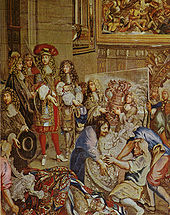 Louis XIV visits the Gobelins with Colbert, 15 October 1667. Tapestry from the series, "Histoire du roi" designed by Charles Le Brun and woven between 1667 and 1672. Articles of Louis XIV's silver furniture are seen in this tapestry.
Louis XIV visits the Gobelins with Colbert, 15 October 1667. Tapestry from the series, "Histoire du roi" designed by Charles Le Brun and woven between 1667 and 1672. Articles of Louis XIV's silver furniture are seen in this tapestry.
In 1667, the name of the enterprise was changed to the Manufacture royale des Meubles de la Couronne. The Gobelins were charged with all decoration needs of the palace, which was under the direction of Charles Le Brun (Bluche, 1991).
One of the most costly elements in the furnishing of the Grands appartements during the early years of the personal reign of Louis XIV was the silver furniture, which can be taken as a standard – with other criteria – for determining a plausible cost for Versailles. The Comptes meticulously list the expenditures on the silver furniture – disbursements to artists, final payments, delivery – as well as descriptions and weight of items purchased. Entries for 1681 and 1682 concerning the silver balustrade used in the salon de Mercure serve as an example:
- Year 1681
II. 5 In anticipation: For the silver balustrade for the king's bedroom: 90,000 livres
II. 7 18 November to Sieur du Metz, 43,475 livres 5 sols for delivery to Sr. Lois and to Sr. de Villers for payment of 142,196 livres for the silver balustrade that they are making for the king's bedroom and 404 livres for tax: 48,861 livres 5 sol.
II. 15 16 June 1681 – 23 January 1682 to Sr. Lois and Sr. de Villers silversmiths on account for the silver balustrade that they are making for the king's use (four payments): 88,457 livres 5 sols.
II. 111 25 March – 18 April to Sr. Lois and Sr. de Villers silversmiths who are working on a silver balustrade for the king, for continued work (two payments): 40,000 livres- Year 1682
II. 129 21 March to Sr. Jehannot de Bartillay 4,970 livres 12 sols for the delivery to Sr. Lois and de Villers silversmiths for, with 136,457 livres 5 sol to one and 25,739 livres 10 sols to another, making the 38 balusters, 17 pilasters, the base and the cornice for the balustrade for the château of Versailles weighing 4,076 marc at the rate of 41 livres the marc[22] including 41 livres 2 sols for tax: 4,970 livres 12 sols (Guiffrey, 1880–1890).
Accordingly, the silver balustrade, which contained in excess of one ton of silver, cost in excess of 560,000 livres. It is difficult – if not impossible – to give an accurate rate of exchange between 1682/82 and today.[23] However, Frances Buckland provides valuable information that provides an idea of the true cost of the expenditures at Versailles during the time of Louis XIV. In 1679, Mme de Maintenon stated that the cost of providing light and food for twelve people for one day amounted to slightly more than 14 livres (Buckland, 1983). In December, 1689, to defray the cost of the War of the League of Augsburg, Louis XIV ordered all the silver furniture and articles of silver at Versailles—including chamber pots—sent to the mint to be melted (Dangeau, 1854–1860).
Clearly, the silver furniture alone represented a significant outlay in the finances of Versailles. While the decoration of the palace was costly, certain other costs were minimised. For example, labour for construction was often low, due largely to the fact that the army during times of peace and during the winter, when wars were not waged, was pressed into action at Versailles. Additionally, given the quality and uniqueness of the items produced at the Gobelins for use and display at Versailles, the palace served as a venue to showcase not only the success of Colbert's mercantilism, but also to display the finest that France could produce (Bluche, 1986, 1991).
Costs of Restoration Programmes
The restoration initiatives launched by the Fifth Republic have proven to be perhaps more costly than the expenditures of the palace in the Ancien Régime. Starting in the 1950s, when the museum of Versailles was under the directorship of Gérald van der Kemp, the objective was to restore the palace to its state – or as close to it as possible – in 1789 when the royal family left the palace. Among the early projects was the repair of the roof over the Hall of Mirrors; the publicity campaign brought international attention to the plight of post-war Versailles and garnered much foreign money including a grant from the Rockefeller Foundation. Concurrently, in Russia, the restoration of the Pavlovsk Palace located outside of Leningrad – today's Saint Petersburg – brought the attention of French museum authorities, including the curators of Versailles (Massie, 1990).
Pavlovsk Palace was built by Catherine the Great’s son Paul. The czarevitch and his wife, Marie Feodorovna, were avid francophiles, who, on a visit to France and Versailles in the 1780s, purchased great quantities of silk, which they later used to upholster furniture in Pavlosk. The palace survived the Russian Revolution intact – descendants of Paul I were living in the palace at the time the communists evicted them – however, during the Second World War, the furniture and artifacts housed in the palace, which had been transformed into a museum, were removed. In the process of evacuation the museum collections, remnants of the silks purchased by Paul I of Russia and Marie Feodorovna were found and conserved. After the war when Soviet authorities were restoring the palace, which had been gutted by the retreating Nazi forces, they recreated the silk fabrics by using the conserved 18th century remnants (Massie, 1990).
When the French authorities saw the results of Russian efforts and the high quality they were able to achieve, the French revived 18th century weaving techniques so as to reproduce the silks used in the decoration of Versailles (Massie, 1990). The two greatest achievements of this initiative are seen today in wall hangings used in the restoration of the chambre de la reine in the grand appartement de reine and the chambre du roi in the appartement du roi. While the design used for the chambre du roi was, in fact, from a design that had been used during the Ancien Régime to decorate the chambre de la reine, it nevertheless represents a great achievement in the on-going restoration at Versailles. Additionally, this project, which took over seven years to achieve, required several hundred kilograms of silver and gold to complete (Meyer, 1989). One of the more costly endeavors for the museum and the government of France's Fifth Republic has been to repurchase as much of the original furnishings as possible. However, because furniture with a royal provenance – and especially furniture that was made for Versailles – is a highly sought after commodity on the international market, the museum has spent considerable funds on retrieving much of the palace's original furnishings (Kemp, 1976).
In 2003, a new restoration initiative – the "Grand Versailles" project – was December , which necessitated unexpected repair and replantation, the project, which will be on-going for the next seventeen years; and with a state endowment of €135 million allocated for the first seven years, the project will address such concerns as security for the palace, continued restoration the bosquet des trois fontaines – representing two thirds of the total cost of the restoration, completed in June 2004 – and VINCI, which underwrote the €12 million restoration project for the Hall of Mirrors, which was completed in 2006 (Leloup, 2006).
We may never know the true amount spent on the creation of Versailles, and most current estime speculative. A recent estimate has placed the amount spent on Versailles during the Ancienme as US$2 billion (Littell, 2000). This figure in all probability is an under-evaluation of the money spent on Versailles. France's Fifth Republic expenditures alone that have been directed to restoration and maintenance at Versailles undoubtedly surpass those of the Sun King.
War uses
After the French defeat in the Franco-Prussian War, with the Siege of Paris dragging on, the palace was the main headquarters of the Prussian army from 5 October 1870 until 13 March 1871. On 18 January 1871, Prussian King Wilhelm I was proclaimed German Emperor in the Hall of Mirrors, and the German Empire was founded.[24]
After the First World War, it was the site of the opening of the Paris Peace Conference in 1919, also on 18 January. Germany was blamed for causing the First World War in the Treaty of Versailles, which was signed in the same room on 28 June 1919.
The ravages of war and neglect over the centuries have left their mark on the palace and its park. Modern French governments of the post-World War II era have sought to repair these damages. They have on the whole been successful, but some of the more costly items, such as the vast array of fountains, have yet to be put back completely in service. As spectacular as they might seem now, they were even more extensive in the 18th century. The 18th-century waterworks at Marly— the Machine de Marly that fed the fountains— was possibly the biggest mechanical system of its time. The water came in from afar on monumental stone aqueducts, which have long ago fallen in disrepair or been torn down. Some aqueducts were never completed for want of resources or due to the exigencies of war. The search for sufficient supplies of water was never fully realised even during the apogee of Versailles' glory as the seat of government, as the fountains could not be operated together satisfactorily for any significant periods of time.[citation needed]
Social history
The politics of display
Versailles became the home of the French nobility and the location of the royal court – thus becoming the centre of French government. Louis XIV himself lived there, and symbolically the central room of the long extensive symmetrical range of buildings was the King's Bedchamber (La Chambre du Roi), which itself was centred on the lavish and symbolic state bed, set behind a rich railing not unlike a communion rail.[citation needed] Indeed, even the principal axis of the gardens themselves was conceived to radiate from this fulcrum. All the power of France emanated from this centre: there were government offices here; as well as the homes of thousands of courtiers, their retinues and all the attendant functionaries of court.[citation needed] By requiring that nobles of a certain rank and position spend time each year at Versailles, Louis prevented them from developing their own regional power at the expense of his own, and kept them from countering his efforts to centralize the French government in an absolute monarchy.[citation needed]
At various periods before Louis XIV established absolute rule, France, like the Holy Roman Empire lacked central authority and was not the unified state it was to become during subsequent centuries.[citation needed] During the Middle Ages some local nobles were often more powerful than the French King and, although technically loyal to the King, they possessed their own provincial seats of power and government, culturally influential courts and armies loyal to them and not the King, and the right to levy their own taxes on their subjects.[citation needed] Some families were so powerful, they achieved international prominence and contracted marriage alliances with foreign royal houses to further their own political ambitions.[citation needed] Although nominally Kings of France, de facto royal power had at times been limited purely to the region around Paris.[citation needed]
Life at court
Life at Versailles was intrinsically determined by position, favour and above all one's birth. The Chateau was a sprawling cluster of lodgings for which courtiers vied and manipulated. Today, many people see Versailles as unparalleled in its magnificence and splendour; yet few know of the actual living conditions many of Versailles august residents had to endure. Modern historians have, on more than one occasion, compared the palace to a vast apartment block. Apart from the royal family, the majority of the residents were senior members of the household.
On each floor, living units of varying size, some 350 in all, were arranged along tiled corridors and given a number. Each door had a key, which was to be handed in when the lodging was vacated. Many courtiers would trade lodgings and group together with their allies, families or friends. The Noailles family took over so much of the Southern Wing's attic that the corridor leading to all the lodgings on that floor was nicknamed "Noailles Road" by courtiers of the time.
Rank and status dictated everything in Versailles; not least among that list was one's lodgings. Louis XIV envisaged Versailles as a seat for all the Bourbons, as well as his troublesome nobles. These nobles were, so to say, placed within a "gilded cage" (Duc de Saint-Simon). Luxury and opulence was not always in the description given to their residences. Many nobles had to make do with one or two room apartments, forcing many nobles to buy town-houses in Versailles proper and keeping their palace rooms for changes of clothes or entertaining guests, rarely sleeping there. Rooms at Versailles were immensely useful for an ambitious courtier as they allowed palace residents easy and constant access to the monarch, essential to their ambitions, and gave them constant access to the latest gossip and news.
The smell at Versailles was said to be "unique out of all the palaces in Europe" (duc Saint-Simon). There were no functioning toilets until 1768. By the time of the French Revolution in 1789 there were only 9, and those belonged to the King and his closest family members. The rest of the palace simply had to live with the constant smell of the privy-chambers clinging to their clothes, apartments and the general atmosphere. Although banned, chamber pots were constantly emptied out of the nearest window.
Musical events
Versailles has held several musical events in modern era.
On 21–22 June 1988, its courtyard played host to Pink Floyd during their A Momentary Lapse of Reason Tour, which was filmed. Footage from the show was used on the Delicate Sound of Thunder video.
Tina Turner played here in 1990 during her Foreign Affair Tour.
On 2 July 2005, the French Live 8 was held in the courtyard of Versailles.
On 29 June 2007, Air played a show at the Palace while on their Pocket Symphony Tour.
In popular culture
Main article: List of films shot at the Palace of VersaillesSinger-songwriter Al Stewart released a song entitled "The Palace of Versailles", a song detailing the French Revolution, The Terror, and the military coup of Napoléon Bonaparte, from the perspective of "the lonely Palace of Versailles".
In the computer game Civilization IV the Palace of Versailles is a Wonder of the World, its name shortened to simply "Versailles".
The progressive metal band Protest The Hero mentions the city in their song entitled "Tapestry", from the album Scurrilous in the reoccurring lyric, "...this is our Versailles."
See also
- The city of Versailles (commune)
- Tennis Court Oath (French: serment du jeu de paume) in the Saint-Louis district
- Versailles Cathedral
- Potager du roi (English: Kitchen Garden of the King)
- Buildings inspired by Versailles
- Bureau du Roi
- Chenonceau
- French Baroque and Classicism
- French Rococo and Neoclassicism
- Subsidiary structures of the Palace of Versailles
- Établissement public du château, du musée et du domaine national de Versailles
Notes
- ^ Official site of the Palace of Versailles
- ^ Versailles, The Dream of a King, directed by Paul Burgess, BBC TV
- ^ Nagel, Susan (2009) Marie-Therese: The Fate of Marie Antoinette's Daughter, Bloomsbury
- ^ With the withdrawal of the king and the court from Versailles, many of those who had been employed either through a member of the royal family or by the court, followed the court and king to Paris. As a result, the population of Versailles fell from 80,000 to less than 25,000 in the weeks that followed 6 October 1789 (Mauguin, 1934).
- ^ Article 16 : L'Empereur visite les départements : en conséquence, des palais impériaux sont établis aux quatre points principaux de l'Empire. – Ces palais sont désignés et leurs dépendances déterminées par une loi. Source: Constitution of 1804
- ^ “Ce que le roi Louis-Philippe a fait à Versailles est bien. Avoir accompli cette œuvre, c'est avoir été grand comme roi et impartial comme philosophe ; c'est avoir fait un monument national d'un monument monarchique ; c'est avoir mis une idée immense dans un immense édifice ; c'est avoir installé le présent dans le passé, 1789 vis-à-vis de 1688, l'empereur chez le roi, Napoléon chez Louis XIV ; en un mot, c'est avoir donné à ce livre magnifique qu'on appelle l'histoire de France cette magnifique reliure qu'on appelle Versailles.”
- ^ da Vinha, Matthieu and Raphaël Masson (2011). Versailles pour les Nuls. pp. p.261.
- ^ da Vinha, Matthieu and Raphaël Masson (2011). Versailles pour les Nuls. pp. p.229.
- ^ Article 9: Le siège du pouvoir exécutif et des deux chambres est à Versailles. Source: Constitution of 1875
- ^ a b Jeff Koons on Jeff Koons Versailles Jeffkoonsversailles.com
- ^ This room originally served as the west landing of the Ambassadors’ Staircase and formed the main entrance to the grand appartement du roi.
- ^ Located in the western cove of the salon d’Apollon and painted by Charles de La Fosse ca. 1674.
- ^ Located in the southern cove of the ceiling of the salon de Mercure and painted by Jean-Baptiste de Champaigne ca. 1674.
- ^ Originally, the room that is known today as the salon de Vénus formed part of the apartment of the king’s mistress, Madame de Montespan. Owing to her involvement with Affair of the Poisons, during which time it was alleged she had been giving the king love potions, she fell from grace in 1678 and her apartment was taken over by Louis XIV at which time the new salon de Vénus was installed.
- ^ Six kings were born in this room: Philip V of Spain, Louis XV, Louis XVI, Louis XVII, Louis XVIII, and Charles X.
- ^ This chapel was the second of chapels built in the château of Versailles
- ^ Owing to the construction of the Hall of Mirrors and the Salon of Peace – the central project of Louis XIV’s Third building campaign – and the death of Marie-Thérèse d’Autriche in 1683, the grand cabinet, the oratory, and the petit cabinet were demolished. Of these three rooms, only fragments of the ceiling decoration of the grand cabinet have survived; no evidence regarding the decoration of the oratory or the petit cabinet has been found (Reynaud and Villain, 1970).
- ^ On an interesting note, not only were women depicted in the decoration of the grand appartement de la reine, but women contributed to the decoration of these rooms. Most notable of these ladies would be Madeleine Boullogne, who painted the over-door painting in the antichambre de la reine (Constans, 1976).
- ^ With the creation of this room, a new chapel – the château’s third – was built in the adjacent room to the east. In 1682, when the third chapel was built (where the salon d’Hercule is now located), this room was renamed la grande salle des gardes de la reine. In the 19th century, this room was rebaptised salle du sacre owing to the installation of Jacques-Louis David’s Coronation of Napoléon I.
- ^ The decoration of this room was an important expression in French interior design. It heralded the transition from the Regency style, which prevailed from the death of Louis XIV through to 1732 (with the decoration of the Salon de la princesse at the Hôtel de Soubise), and the Rococo (or style Louis XV), the style that prevailed for the greater part of the reign of Louis XV.
- ^ It was through this room that the Paris mob, which stormed the château during the night of 6/7 October 1789, gained access to the château. During the mêlée, members of the garde Suisse, which formed part the queen’s bodyguard, were killed in their attempts to protect the queen.
- ^ The marc, a unit equal to 8 ounces, was used to weigh silver and gold.
- ^ As of 4 April 2008, silver has been trading in New York at US$17.83 an ounce.
- ^ Wawro, Geoffrey, The Franco-Prussian War: the German conquest of France in 1870–1871, (Cambridge University Press, 2003), 282.
Further reading
- Thompson, Ian. The Sun King's Garden: Louis XIV, André Le Nôtre And the Creation of the Gardens of Versailles. London: Bloomsbury Publishing, 2006 (hardcover, ISBN 1-58234-631-3).
Sources
Book Sources
- Balzac, Honoré de (1853). La comédie humaine. Volume 12. Paris: Pilet.
- Bendix, Reinhard (1978). Kings or People: Power and the Mandate to Rule. Los Angeles: University of California Press.
- Benichou, Paul (1948). Morales du grand siècle. Paris: Éditions Gallimard.
- Berger, Robert W (1985). In the Garden of the Sun King: Studies on the Park of Versailles Under Louis XIV. Washington, DC: Dumbarton Oaks Research Library.
- Berger, Robert W (1986). Versailles: The Château of Louis XIV. University Park: The College Arts Association.
- Blondel, Jacque-François (1752-1756). Architecture françoise, ou Recueil des plans, élévations, coupes et profils des églises, maisons royales, palais, hôtels & édifices les plus considérables de Paris (4 volumes). Paris: Charles-Antoine Jombert.
- Bluche, François (1986). Louis XIV. Paris: Arthème Fayard.
- Bluche, François (1991). Dictionnaire du Grand Siècle. Paris: Arthème Fayard.
- Blunt, Anthony (1980). Art and Architecture in France 1500 to 1700. Harmondsworth, Middlesex, England: Penguin Books.
- Campbell, Malcom (1977). Pietro da Cortona at the Pitti Palace. Princeton: Princeton University Press.
- Castelot, André (2001). Charles X. Paris: Perrin.
- Choquette, Leslie (1997). Frenchmen into Peasants: modernity and tradition in peopling of French Canada. Cambridge, MA: Harvard University Press.
- Combes, sieur de (1681). Explication historique de ce qu'il y a de plus remarquable dans la maison royale de Versailles. Paris: C. Nego.
- Dangeau, Philippe de Courcillon, marquis de (1854–60). Journal. Paris.
- da Vinha, Mathieu and Raphael de Masson. Versailles pour les Nuls. ISBN 2754015523.
- Félibien, André (1674). Description sommaire du chasteau de Versailles. Paris.
- Dutilleux, Adolphe (1887). Notice sur le Museum national et le musée spécial de l'École française à Versailles (1792–1823). Versailles : Impr. de Cerf et fils.
- Félibien, André (1694). La description du château de Versailles, de ses peintures, et des autres ouvrages faits pour le roy. Paris: Antoine Vilette.
- Félibien, Jean-François (1703). Description sommaire de Versailles ancienne et nouvelle. Paris: A. Chrétien.
- Guérard, Benjamin (1840). Cartulaire de l'abbaye Saint-Père de Chartres (2 volumes). Paris : Imprimerie de Crapelet.
- Guiffrey, Jules (1880–1890). Comptes des bâtiments du roi sous le règne de Louis XIV. 5 vols. Paris: Imprimerie Nationale.
- Hugo, Victor (1972). Choses vues, 1836–1846. Ed. Hubert Tuin. Paris: Gallimard.
- Josephson, Ragnar (1930). Nicodème Tessin à la cour de Louis XIV. Paris et Bruxelles: Les Éditions G. van Oest.
- La Varende, Jean de (1959). Versailles. Paris: Henri Lefebvre.
- Lighthart, E. (1997). Archétype et symbole dans le style Louis XIV versaillais: réflexions sur l’imago rex et l’imago patriae au début de l’époque moderne. Doctoral thesis.
- Littell, McDougal (2001). World History: Patterns of Interactions. New York: Houghton Mifflin.
- Manse, Philippe (2004). Louis XVIII. Paris: Perrin.
- Marie, Alfred (1968). Naissance de Versailles. Paris: Édition Vincent, Freal & Cie.
- Marie, Alfred and Jeanne (1972). Mansart à Versailles. Paris: Editions Jacques Freal.
- Marie, Alfred and Jeanne (1976). Versailles au temps de Louis XIV. Paris: Imprimerie Nationale.
- Marie, Alfred and Jeanne (1984). Versailles au temps de Louis XV. Paris: Imprimerie Nationale.
- Massie, Suzanne (1990). Pavlosk: The Life of a Russian Palace. Boston: Little, Brown, and Company.
- Mauricheau-Beaupré, Charles (1929). Le château de Versailles. Paris: D. A. Longuet.
- Mauricheau-Beaupré, Charles (1949). Versailles. Paris: Draeger et Veive.
- Monicart, Jean-Baptiste de (1720). Versailles immortalisé. Paris: E. Ganeau.
- Nolhac, Pierre de (1901). La création de Versailles. Versailles: L. Bernard.
- Nolhac, Pierre de (1911). Histoire de Versailles. 3 vols. Paris.
- Nolhac, Pierre de (1925). Versailles, résidence de Louis XIV. Paris: L. Conrad.
- Nolhac, Pierre de (1926). Versailles au XVIIIe siècle. Paris: Louis Conard.
- Oppermann, Fabien (2004). Images et usages du château de Versailles au XXe siècle. Thesis, École des Chartes. http://theses.enc.sorbonne.fr/document128.html.
- Piganiol de la Force, Jean-Aymar (1701). Nouvelle description des châteaux et parcs de Versailles et Marly. Paris: Chez Florentin de la lune.
- Sabatier, Gérard (1999). Versailles, ou la figure du roi. Paris: Albin Michel.
- Solnon, Jean François (1987). La cour de France. Paris: Fayard.
- Thompson, Ian (2006). The Sun King's Garden: Louis XIV, André Le Nôtre, and the Creation of the Gardens of Versailles. London: Bloomsbury Publishing.
- Verlet, Pierre (1945). Le mobilier royal français. Paris: Editions d’art et d’histoire.
- Verlet, Pierre (1985). Le château de Versailles. Paris: Librairie Arthème Fayard.
Journal Sources
- Baillie, Hugh Murray (1967). "Etiquette and the Planning of State Apartments in Baroque Palaces". Archeologia CI: 169–199
- Batiffol, Louis (1913). "Le château de Versailles de Louis XIII et son architecte Philibert le Roy". Gazette des Beaux-Arts 4 pér., vol. 10, November: 341–371
- Batiffol, Louis (1909). "Origine du château de Versailles". La Revue de Paris April: 841–869
- Berger, Robert W (1980). "The chronology of the Enveloppe of Versailles". Architectura 10: 105–133
- Bottineau, Yves (1988). "Essais sur le Versailles de Louis XIV II: le style et l'iconographie". Gazette des Beaux-Arts 6 pér., vol. 112, October: 119–132
- Brière, Gaston (1938). "Le replacement des peintures décoratives au 'grands appartements' de Versailles". Bulletin de la société de l'histoire de l'art français: 197–216
- Buckland, Frances (1983). "Gobelin tapestries and paintings as a source of information about the silver furniture of Louis XIV". The Burlington Magazine 125 (962, May): 272–283
- Constans, Claire (1976). "Les tableaux du Grand Appartement du Roi". Revue du Louvre #3: 157–173
- Constans, Claire (1985). "1837: L'inauguration par Louis-Philippe du musée dédié 'À Toutes les gloires de la France'". Colloque de Versailles
- Constans, Claire, Claire (1987). "Encadrement et muséographie: l'example du Versailles de Louis-Philippe". Revue de l'Art 76: 53–56. doi:10.3406/rvart.1987.347630
- Fromageot, P (August 1903). "Le Château de Versailles en 1795, d’après le journal de Hugues Lagarde". Revue de l’histoire de Versailles: 224–240
- Gatin, L.-A (August 1908; November 1908). "Versailles pendant la Révolution". Revue de l’histoire de Versailles: 226–253; 333–352
- Gaigneron, Axelle de (October 1974). "La stratégie de Louis-Philippe à Versailles". Connaissance des Arts 272: 74–80
- Gruyer, Paul (1920). "Les plafonds de Versailles". La Renaissance de l'Art Français January: 250–259
- Hoog, Simone (1976). "Les sculptures du Grand Appartement du Roi". Revue du Louvre #3: 147–156
- Johnson, Kevin Olin (1981). "Il n’y plus de Pyrénées: Iconography of the first Versailles of Louis XIV". Gazette des Beaux-Arts 6e pér., vol. 97, January: 29–40
- Josephson, Ragnar (1926). "Relation de la visite de Nicodème Tessin à Marly, Versailles, Rueil, et St-Cloud en 1687". Revue de l'Histoire de Versailles: 150–67; 274–300
- Kemp, Gerard van der (135-137). "Remeubler Versailles". Revue du Louvre #3: 1976
- Kimball, Fiske (1949). "Genesis of the Château Neuf at Versailles, 1668–1671". Gazette des Beaux-Arts 6 pér., vol. 35: 353–372
- Le Guillou, Jean-Claude (1989). "Aperçu sur un projet insolite (1668) pour le château de Versailles". Gazette des Beaux-Arts 6 pér., vol. 113, February: 79–104
- Le Guillou, Jean-Claude (1983). "Le château-neuf ou enveloppe de Versailles: concept et évolution du premier projet". Gazette des Beaux-Arts 6 pér., vol. 102, December: 193–207
- Le Guillou, Jean-Claude (1976). "Remarques sur le corps central du château de Versailles". Gazette des Beaux-Arts 6 pér., vol. 87, February: 49–60
- Leloup, Michèle (7 August 2006). "Versailles en grande toilette". L'Express. http://www.lexpress.fr/mag/arts/dossier/patrimoine/dossier.asp?ida=451314.
- Lemoine, Pierre (1976). "La chambre de la Reine". Revue du Louvre #3: 139–145
- Mauguin, Georges (1937). "L’Inauguration du Musée de Versailles". Revue de l’histoire de Versailles: 112–146
- Mauguin, Georges (July 1940 – December 1942). "La visite du Pape Pie VII à Versailles le 3 janvier 1805". Revue de l’histoire de Versailles: 134–146
- Meyer, Daniel (1985). "Un achat manqué par le musée de Versailles en 1852". Colloque de Versailles
- Meyer, Daniel (1989). "L'ameublement de la chambre de Louis XIV à Versailles de 1701 à nos jours". Gazette des Beaux-Arts 6 pér., vol. 113, February: 79–104
- Nolhac, Pierre de (1899). "La construction de Versailles de Le Vau". Revue de l'Histoire de Versailles: 161–171
- Pradel, Pierre (1937). "Versailles sous le premier Empire". Revue de l’histoire de Versailles: 76–94
- Reynaud, Nicole et Jacques Vilain (1970). "Fragments retrouvés de la décoration du Grand Appartement de la Reine Marie-Thérèse". Revue du Louvre #4–5: 231–238
- Sabatier, Gérard (October/décember 1988). "Le parti figuratif dans les appartements, l'escalier et la galerie de Versailles". XVIIe siècle no. 161: 401–426
- Saule, Béatrix (1992). "Le premier goût du Roi à Versailles : décoration et ameublement". Gazette des Beaux-Arts 120, October: 137–148
- Société des Sciences morales, des Lettres et des Arts de Seine-et-Oise (1925). "La Donation Rockefeller en faveur de la restauration du château de Versailles". Revue de l’histoire de Versailles: 194–200
- Walton, Guy (1977). "'L'Enveloppe' de Versailles: réflexions nouvelles de dessins inédits". Bulletin de la Société d'Histoire de l'Art français: 127–144
External links
- Official Site
- Virtual Tour of the Palace (fullscreen panoramic tour)
- Large Versailles photo gallery
- Flickr : Le Parc de Versailles
Royal palaces and residences of the Kingdom of France Palace of Versailles (including the Grand Trianon and Petit Trianon) ·
Louvre Palace · Palais-Royal · Tuileries Palace · Luxembourg Palace · Château de Marly · Château de Blois · Château de Chambord · Château de Choisy · Château de Compiègne · Palace of Fontainebleau · Château de la Muette · Château de Saint-Cloud · Château de Saint-Germain-en-Laye Categories:
Categories:- Art museums and galleries in France
- Baroque architecture at Versailles
- Buildings and structures completed in 1672
- Buildings and structures completed in 1684
- Châteaux in France
- French formal gardens
- Gardens in Yvelines
- Landscape design history of France
- Palace of Versailles
- Palaces in France
- Parliament of France
- Royal residences in France
- Seats of national legislatures
- World Heritage Sites in France
Wikimedia Foundation. 2010.

